Authors: Brian Hudelson, UW-Madison Plant Pathology
Last Revised: 01/23/2019
X-number: XHT1009
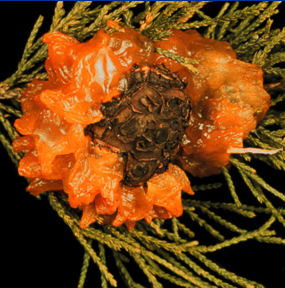
What are Gymnosporangium rusts? Gymnosporangium rusts are a group of closely related diseases caused by fungi that infect both junipers (in particular red cedar) and woody plants in the rose family (such as, but not limited to, apple, crabapple, hawthorn and quince). These fungi must infect both types of plants to complete their life cycles. The most common Gymnosporangium rusts found in Wisconsin are cedar-apple rust, cedar-hawthorn rust and cedar-quince rust. The names of these diseases are somewhat misleading, given that all three diseases can affect multiple rosaceous hosts in addition to those referenced in their names.
What do Gymnosporangium rusts look like? On junipers, symptoms of Gymnosporagium rusts vary. Cedar-hawthorn and cedar-apple rust fungi induce formation of irregularly-shaped brown galls, with cedar-hawthorn rust galls tending to be smaller in size (approximately 1/8 to 9/16 inch in diameter) than cedar-apple rust galls (approximately 1/4 to 2 inches in diameter). Both types of galls produce distinctive slimy, orange, gelatinous appendages in the spring. In contrast, the cedar-quince rust fungus causes juniper branch swellings. Orange spores ooze from these swollen areas in the spring.
On rosaceous hosts, Gymnosporangium rust symptoms also vary. Symptoms of cedar-hawthorn rust and cedar-apple rust appear in mid to late May, typically as circular, yellow-orange areas on leaves. Eventually, tube-like structures (that have a fringe-like appearance) form on the undersides of leaves beneath the yellow spots. Symptoms of cedar-quince rust typically become obvious later in the summer (most commonly on hawthorns) as swollen, spiny branches and/or fruits.
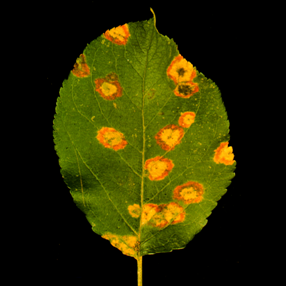
Where do Gymnosporangium rusts come from? Several fungi in the genus Gymnosporangium cause Gymnosporangium rusts. These include Gymnosporangium juniperi-virginianae (cedar-apple rust), Gymnosporangium globosum (cedar-hawthorn rust), and Gymnosporangium clavipes (cedar-quince rust). These fungi overwinter in infected branches and galls on junipers. Spores oozed from the infected branches or produced in the gelatinous gall appendages drift to rosaceous hosts leading to leaf and fruit infections. Similarly, spores produced in the tube-like structures/spines on rosaceous leaves and fruits drift to junipers leading to new branch infections and additional gall formation.
How do I save a tree or shrub with Gymnosporangium rust? Gymnosporangium rusts are primarily cosmetic diseases that make susceptible plants unattractive, but rarely have long-term detrimental effects. Gymnosporangium rusts on leaves can, for all practical purposes, be ignored. Gymnosporangium rusts on juniper branches can be easily managed by pruning approximately four to six inches below swollen areas or galls. Rosaceous hosts with infected branches can be pruned similarly. Be sure to decontaminate pruning tools between cuts by dipping them for at least 30 seconds in 70% alcohol (e.g., rubbing alcohol) or 10% bleach. Alternatively, you can spray tools with a disinfectant that contains approximately 70% alcohol, then allow them to air dry. Decontaminating tools will prevent movement of rust fungi from branch to branch or from plant to plant during pruning.
How do I avoid problems with Gymnosporangium rusts in the future? The best way to avoid Gymnosporangium rusts is to not grow junipers (particularly red cedar) and susceptible rosaceous hosts close to one another. In urban settings where yards are small however, keeping both hosts adequately separated may be impossible. Where Gymnosporangium rusts have consistently been a problem, consider using evergreens (e.g., pine, fir, spruce) and flowering trees and shrubs (e.g., cherry, plum, lilac) that are immune to these diseases. If you decide that you want to mix junipers with apple, crabapple, hawthorn, and quince on your property, check at your local nursery for resistant varieties that will satisfy your landscaping needs. In general, Chinese junipers (Juniperus chinensis) tend to be relatively resistant to Gymnosporangium rusts.
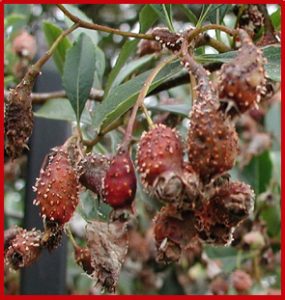
Fungicides treatments are also available to control Gymnosporangium rusts, although such treatments should be considered only as a last resort. Among fungicides marketed for use by home gardeners, those containing chlorothalonil, copper, mancozeb, myclobutanil, propiconazole, and sulfur are labeled for use for Gymnosporangium rust control. These products may be useful for controlling Gymnosporangium rusts on rosaceous hosts, but will likely not be particularly effective if used on junipers. For optimal control on rosaceous hosts, apply treatments when flower buds first show color, when half of the flowers are open, at petal-fall, seven to 10 days after petal fall and finally 10 to 14 days later. Be sure to read and follow all label instructions of the fungicide(s) that you select to ensure that you use the products(s) in the safest and most effective manner possible. In particular, be sure that you select appropriate products when treating trees and shrubs with edible fruit. If you decide to use propiconazole or myclobutanil, alternate use of these active ingredients with use of at least one of the other active ingredients listed above (but DO NOT alternate propiconazole with myclobutanil) to help minimize potential problems with fungicide-resistant strains of Gymnosporangium.
Download Article





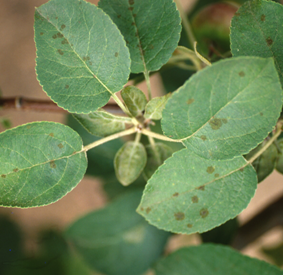 Apple Scab
Apple Scab Fire Blight
Fire Blight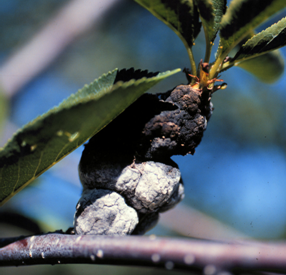 Black Knot
Black Knot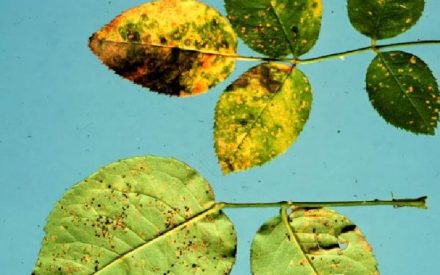 Rose Rust
Rose Rust


